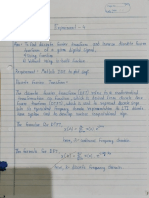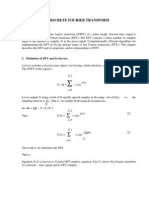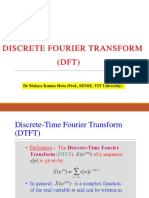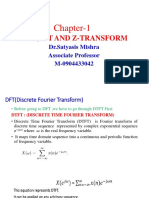0 ratings0% found this document useful (0 votes)
63 views32 pagesDFT Notes With Examples
Uploaded by
4zfq8g84rkCopyright
© © All Rights Reserved
We take content rights seriously. If you suspect this is your content, claim it here.
Available Formats
Download as PDF or read online on Scribd
0 ratings0% found this document useful (0 votes)
63 views32 pagesDFT Notes With Examples
Uploaded by
4zfq8g84rkCopyright
© © All Rights Reserved
We take content rights seriously. If you suspect this is your content, claim it here.
Available Formats
Download as PDF or read online on Scribd
You are on page 1/ 32
MODULE- 1.3 DISCRETE FOURLER
TRANSFORMS (DFT)
To pexforsen preqnency analysis en a discrete time
Sequence alm), we convent time -domalu sequence
fo an equivatomt frequency domain represemtation.
eplyiong Fourier Tramforrm om x(n), we qe x(oo) ,
Which is Comtinuoun And periodic Aumction of frequeny
dt is mot a computationally comvemient ye presentation
of the Sequence x(n).
Representation o| a Sequenct stn) by samples Of tts
} 4 | pe
Spectrum X(w) is Know % the Discrete Fourier
Tramsjorem (D PT ).
FREQUENCY. DOMALN SAMPLING §—
W.K.T aperiodic ferite energy signals hase
Comtimuew spectta.
Fourier Tromsfoven (F1) nf Aperiodie DIS sem)
is given by
@ .
Xw)= AZ xme" —_@
M= -00
Since X(w) is periodic, with perioet on , oenty
Sampler in Ma fardarmemtak frequemey vomae are
obtcumed by sarmpbug periodically im frequemey at
4
a
a spacing of Sw yadans between successive
sacmples. We take N equidistont sacmplea im the
interval 02we2o0T with 3 oclug Sw = 27,
P N
{
1
1
1
|
!
|
I
' I
roy
ed
ee |
9 eee,
>
Substituting, ws atk in a @,
@ —jon
oT ee J kn
x (2x) = Zz a(n) @ oN —o@
M=- 00
whene k= 0)1;2);--.,No4
Summation im equ cam be subdivided iat
iengjenite mnucmloan 4 sumamatievs, where ede
sum Comtalms N_ ferms.
ee kn
a x(He) = ot Z use
N n=-N
as vem kn
Z a) elke * 2 x(n) e
tse
400 IN+N-4 —j2 em
= Ey ott
=-~@ n=IN
Th we change the index im the immer summation
from ~ to n-LN amd imterchanoe the order of
Summation, Wwe eet,
N-l oe :
x (ate) = S a(n-J2N) eon
n=0} J=-00
Poy 20) 1,2) ...,N-4-
-j jam
Put eee -aNn) = Suet Ne ee
jopedy wom =4
whew e@
Hd +o ott
° _ Joe
eo x(2te) = 2 Z x(n a9| ene”
aco L t=-@
L—6
Let xp(n) = eZ xtm-dn) —®&
=~ 00
xplm) is obtalued by the periodic repetition of s(n)
eveny N sowmples. dt is periodic voit fumdormentort
period N.
sxpln) com hence be expamoad im a Fourier Series
Nol .
+ 42m
winh= AOE e wEM __6)
k=0
N= 0)1,2,.-.,N-t
as
with Fourter coef pices,
= eu
= + z xp(m) © wen —6
N=0
Ke Optpee.y Not
Comparing equs © «©,
CE = Ay (ate) SK=0,)1)...NO
—@®
Substituting equ® tn eq,
be jatien
apn) = y(AAeye No
i N =o ( S ) ®
Equation @) provides the recenstuction of the periodic
signal pln) from the samples of the spectrum X(co}.
Hower, to recody Klos) OY ln) from the samples
certaim comditten needs to be satisfied.
Since pC) js the periodtc extensien % cn) » it
is clea thot x(n) Can be retovened from xpln)
ip fhere is 10 mo_aliasing im the time domain i.e,
iP oclm) is time ieited do dese than the period
N of Xp (en).
@ xp)
- IT.. .
® p Zot :
CT
W2L
“aplen) HO ALIASING
“Tani,
Comeiler 98, alm) ie a sequence mnonzre in
the imterval o2M41-1.
©
When NZ (m) = tpl men
om L, xlm) = 1pln) for penen 1[ & 6|
Hewce x(n) Com be recovdud frorn peri).
Whon N2L, '& cammot be rewred dus ft,
Crane — domain aliasing.
THE DISCRETE FOURLER TRANoFORM (DFT)
$en gqemeral , the eqpoly spaced lreqpency contre
x(2t- re) PROM hh, do snk wriquons vepren
the original sequence, %(0) Who ~Cn) bos
duvalio.
6
Imstead, the frequency sanples x(2%e) Covrespernal
fo a periode Sequence Xp) of period N, Whe
Xpln) is am aliased version of xm) glvew by
xp(m) = E xln-n)
= -00
When the Sequence x(m) has a fevite dusratien of
senoth Len, theu xp) is serpy a periodic
repetitien 4 x(n), where Zl) over a siengle periool
is given by,
Kplm) = pu, Oemel-1
0, Lemen-4
Hence, the freqrency sacmpler x (2m) , K=0,1,..,N
uniquely represent the fimite duration Sequemee xlon),
Since xl) = tpl) over A simate period ( padded
by N-L 2evs), the original fimite duration
sequence x(n) com be obtained from the prequemey
sSaemples x (24K) from equ ©.
Suamenarising . A fimite - duration sequence
aln) 4 Jengtc | haa a Fourier fransforen
X(wo) = z auton) @ , 0fWeeT
m=0
Limtts imdicat x0) is ze outsicle the van eo
Oe=mMm41-4, J
+
When we Sample Xu) at equally spaced frequencies
Gop= SME) K=0)..yN-1 Whe NZL, the samples are
X(e) = x (AE) = Same lefen
N=0
ee —j20 em
ty | Xk) = EZ. ume N Pee
m= 0 arta)
Upper index in the sum ha been imcreaved
from L-4 to N-4 sionce x(n) =0 for MEL.
dhe above relation is a fovemule. fer Cramsforrniiong
O sequence Soctord | demotr LEN imto a
Sequence op brequemncy sanyples b xc} of demos
N.
Since , the prequesncy Sampler ake obtained b
evaluating the Fourier traastorm X(u) at a
set of N Ceqpatty spaced) discrete prequemctey,
the above relation is called discrete Fourier tromshvam
(DFT) of xl).
Let Wy = eV | then
oe kn
wef Xk) = ZB xm) wy ke o.u9,
n=0 “i
8
She velotion which allows us dB recover the
Sequence x(m
) from the frequency samples
is called the Imuerse DFT ( IDFT),
DET AS A LINEAR TRANFORMATION
Wk,
Nel
DFT | amy} = X(kK)= & xm) we
N=0
K=O,1,2,...,N-1
N-I -
TDeT } xe = xn) = + = xe) Wee
k=6
M=0,1)2,.-,N—1
—jot
N Twiddle Factor
whore Wy = ©
From the above equations we observe that the
Computation. 4 each point of the DFT. requires
N= Complex cmultiplicections and (N-1) Commplex.
additions.
Heave, N=point DFT veqpives N” Complex smattiplicsti¢ns
and N(N-1) complex additions. _
q
DET amd IDFT Caw be Wewed a dimear tawstor—
mations om sequences { xem} and } xe}, respectivety,
Let us defame Q N-poimt vector xy of the sigma
Sequence alm), am N-point vedor Xy of Prequemuy
Samples amd A NXN matrix Wy as
[ x00) Xl)
mye | 2 Xy=] xt)
L x(n) X(n-1)
-f— . : o(N-1)
Wn = we? oe a oe
wee wit wir)
“tuo | (HDA (N-1)Cn-1)
| wd ‘Jo Wr a Wy
r 4
Ove eee ee
N-)
4 Wy Wa Wy
2(N-1)
4 Wy wy! : » Wn
‘ ’ aTNe ne (ion)
owe wat) wh
From the above dlfienitioms, the N-poimé DFT
cam be expressed im matrix om a
Xu = WyXn :
Whae Wy is the matrix % dhe Linear transformation,
We obserwe trot Wy Is a symmetric omatrix. If
we assume that tmvenrse of Wy exists dren IDET
com be expresred im matrix fore n
X= Wy Xi
or] xy = 4 Wa Xy
whee Wir demotes the Complex onjugati. Of, Wy.
PROBLEMS
4) Compute the 4- poimt = DFT 1 a sequence
aten) = | 4273, 4):
Solm!— T- METHOD ¢
From the defn oi DFT wkt,
Nol
pet} xen) = x(k) = & x(n) wh”
=
j K=O; pN-|
m= 0
Giver N=4,
2 kn
a Kk) = Ex) Wy
N=0
= rl) + 2G) WE + 20) Wy + aCe) Wy
3Ic
[xe = 4 towP tawy tag | 5 kona
Twiddle Factors 3 For N=H, Fiyst four twiddle faders.
arF
Wa=t Wy =-f
4 : 3 °
Wy=-j We =J
POWERS -j J car Use Wy = e a and
a
Solve.
let r=0, X(o)= 4+ 2 +344 = 10
2 3
Let k= 4, XC) = 4 + 2QWy £3Wy + 4 Wy
4 4 2(-j) + 3-1) + 4G)
i}
-2+2)
uw
Letts, X(@2) = 4 + 2wP + Swi +t 4we
= t+ 2(-4) + 3(1) 44(-4)
= -2
a6 4
Let Kea, X@) = 4 bP Wy + Oy + 4 Wy
ree ne) makes cael) ety (e))
= =2-95
x xCe) = 4 10; =942)) -2, -2-95) |
\o
Teron «+
Xu = Xn Wy Xn & Xn > Row vectors
oma) Xy = xy Wy
[4 asu4ulf[4 4 4 4
4 WE Wig Wy
Awd Wal vue
Lowe We Wy!
Fromm periodicity Propaty of Wat eee i
= Wy
and symmetry Propaty 5 we - we
y -Creeu\fs t+ tt
4 -j -b J
ieee ee la
4 j -bo
Additiomal problems en DFT t-
2) alm) = fo, 412,38} for Nett
ANS? X(k) = 6, 242), -2, ~2-9}}
3) atm) = | 4,2, 9, 4) doy NEY.
ANS! XC) =f 6 -1-j, 0, -14)h
1d
4) ln) = Sen) + Sln-1) = S(m-2) ~ s(m-a)
~ } 1, 4, -4,-2\
ANS} X(r) = ( 0, 2-2) , 0, 2425}
5) Find the k-polnt rper % x(k) = i lo,
ae +2],
~2 ,-2-2)}.
Self — From the defn of IDFt,
No} a
rort 4 xle)} = x(n) = 1 Z. x(t) War”
N “tee
M = Oh Dp.-y Not
for Neu, 3 er
xm) = 1 = XC) Wy
4 20
xm) = [ Xo) + xX) Wy + x(2) wy”
+x(3) wa?” |
ax) = + [ 10 + (9424) Wy” + C2) Wy
31 -
+ (2-2) Wa | 7 = O14, 2/3.
TINIDDLE FACTORS$
Tor Ne4,
4 ° oO] —2
+] Wy = 4 Wy =-4
\ “48 3 °
2—+——— 4-0 Wy = J Wy =-)
j
[ lo + (-242]) Wye + (C2) Way?
+ (2-9j) Wa |
[ to + Gat2})Cj) + C2(-2)
+ C22) |
x(4) = - =o
Let m=2,
x(a acl to + (+9) wy? + Co) vy
+ 2-9]) wy ® |
= y to + (-2423) (-1) + @2) (4)
42-95) (4) |
xb) = “a = 3
Let m=%, (8) = i [" to 4 bats a vy +2) Wy
(2 }) Wo VI
_ ‘ y -
Se see = f4,2, 3,4 |
ZI METHOD ¢— Cos “kn
wet, um) = + & X(kc) Wa
‘ Neo
Abwe equatien carn also be written aa,
= * —> Row
"= NN Xn ww Xn Xn Vectors,
Given N=4, %
Xy = 7 Xy Wi
1 ‘ P ht 4 4
Xq =f to G242j) -2 C2-2)) :
‘ 4 j ---J
4-4 4 -4
4 -j -1t J
= LT 1 -2+9j-2-2-2} 4
4 -oj-2 +942)-2] = 4 3
\o -2) J —
(0 t2-2)-2 42 424 4 Io
WO 4o)42 42-2) 42 l6
NOTES ANSWER
do) a(n) = 1,2,3,4)
Ts IN Row,
REPRESENTED As
COLOMN ONLY FoR
CONVENIENCE,
© Find the DET of xn) = Sem),
Sol i- From dafin cs DFT,
Nol
DET a(n) } = xX) = 2 xm) we”
2.
N=0
NzI
Hence, DFT Sén) | = z S¢n) rae
N=0
WAT, S(m) = 4, ob N=0
0; tor n¢0
2 DET L som} = StolWy = ty
rs
or $m) ems +
@ find the PFT ob, x(m) = S(m-M).
solm:— From =the defin of DFT,
net kn
DET j tnd} = xX) = Z xl) Wr
N=0
Noy kn
Herre, pet | stn-mo)} = SF S(m-m) Wy
M=0
4, at N=No
reall -Mo) = !
\W.K-T, (nm) Vo eae
ko
Go DET | Slm-m)) = SO) Wy? = Wyrm
$(n- No) pales ae
jot
© Fimd N-point DET x(n) = ewe".
Solan — From de gienition 4 DFT
Nel
oer j cxler) | = xh) = & x(n) we
7:
Hence, pet | oe aa aw
N
Noe n
—j2 ¢y- ° 2
nl -[ oe tI] Z
I
XC) - Po
i -J2T (e- ko? = ___—
_ fa I- a
ak Keke, x(e) = & ; Using} L-Hospifals Method ,
(-" eo POs)
6 -
= - cist Ce Ke)
- _pm elt Ce ts)
0 (-§ " keto
Ae KaKop ©
= jam. € = N
=r 8
Jol.e
N
& Xe) = Nat Ke ko
ak kK#Kko x(k) =
N at k=ko
[xGe = WN sCe-ra} m p= |
0 fr Eto
@ Find the DFT oh x(n) = et kom
Solo'- From the defn of DFT,
N
pet ham} = xe) = SF xen) wh”
=o
. N-1 vot -]
= -j27 J2M ben
Hence, DET fe 1 koro} =e Teoma!
N=0
\\
[ ox Cerra
n=O
M
-
\
c—_
o
ea
WE
fe
a
iN
&
I
x
NN
®3
m0
Nt]
y = Il-a@
- 21 Cette) ee
a- eR rl
oe - O
ok k= ko, XC) = —-
0
Using L- Hospital Rode,
7S (-ie") el TICict to)
XQ) =
\ — PT Ck +b)
—)20 0.
mac at) & yy keke
atk=-te, X(kh)=e YU = N
A
at kK t-ko, Xk) = 0 oo
Not keko
ce [xce) = N Se +o) | oy |x(e) = Oot
ov X(k) = N SCK-N tke) ; oa
‘4
Find the N-point DFT of x(m) = Cos 2 kom
N
Solmi— From depo of DFT,
N-I
«
DET {x(n } = Xk)= 4 xm we”
=0
per | taal (om Teom){ = Z Eun) vin
N
N-t eA
iat | othe —)2M jeen
e N
20
Ce
Not 2M (kK Ko)n 2 dere?
= gen —~
1-0
Nt _32T (h+ ko)
+ ee 1 (ett i
M=0
eal | NSCe- bo) + NS Ce+ta)h
“ bos ( 2.x) pe & { Slee) + § Cettal
@ Simi los problerm , a(n) = sim 20 kon
ans: 30 ( en) SM [ SCe- vo) Stet to)|
>]
20
(@ Fimd the 5- pam DFT Hh x(n) = } i, 1,4]
SelM j From the dep of DFT, ower
y
N-I
Xe) = atm) wh
M=0
Q
a4
a
R
3
a)
I
Ke Ot.) NOI
thiven N=S,
A
X(k) = = xn) we jp Ke 0,4, 2,3,4
X(c) = tle) + CWE + 26) tale + b2) We
# x(a) Wel
yle) = EWE We | ke aya
|
Twiddle Fadyst N=S
We = 4
We = oF cos (22\-3 sim (227)
0.2090 — 0.96
We = eV? woe (a) | vin (10)
Ocoq jose es
We = ¢ iN (ws ( eu j an)
o.noq 4 JOSST
a1
—j 20.4 st) _ | sin fst
Wie = @ 5 = tos ( $2) J sin (2m)
= 0.309 + J 0.98
Evawoat x(k),
at k=0 xf) = ttttt =
(lo
t
W
at kK=4, X(4) t two + we
an
os - jis3ge
at K22, XG) = t+ We + Wel = os + jo.3633
3 6 .
at Kea, K(s) = + + Ws + Ws = 0.8 ~j 0.3685
at coh, XG) = D4 Wel + We = oS +] Lees
X(c) = | 3, 0S —jl.538g, 0.5 +) 0-363,
0.502633, 0S + J 15388 5
@ Hed IFT fpr the following sequence
Xte) = | 1, 9, Wi), 0, 4, 0, WHi),0f
Sol*n:— Lemath 4 the Sequence is 8,
eo N=8
From the difin Of IDET,
sot} xtc} = xem) = 4 Z Xe) Wy
a2
For N=8,
E eck
E X(t) W,
K=0
x(n) =
a
g
x(m) = + RCO) eerx Cl) eae) lea
sm
+ xO) we?” + XG) We" + XC5) We
- -4
+ X(6) Wen” + X(T) We "|
axl) = t [ eS) Ome (|) | 0 peti
+0 + (i ‘Due + o|
wnare n= 0/1,2,...,F
xm) = 4 [ See awe?” i Wey (is) a
or
TWLDDLE FACTORS 5 Nes
2
cI -4
IMs we
= 0.404 +) 0F0F ;
oA OF0F +JOF0F OY pieeelay
Ws Ve
oO
1 We
— o
“A
Wet
8 Wa
23
For m=0, X(0) = | Shtiejytat ij
tL
g
-=SB st
g =
For m= 4, a(t) = 4 J s + (-J)wg” + We!
+ (i) wet
S s +0-j)j + C+ (aie
M
"
+
4p stinr-t alg
&
ar)
q
”
For m22, 20) = t Js + (A)) We + We °
+) wg? }
= 4 | s4O-Q) +r ++ GHD]
= ¢ [5-145 +1-1-J]
a
a
12
4 \s + (-J) We + We
(4}) we? }
fir mz3, (2)
-4 | SHC) +O) +H}
24
wo) 2g bs jrP-tti re)
. 7a |
ad fs-j-r-1+j-1} ° $7
formen, or) = b | st Cine? + wey
a+j) wg |
a + 5 s +Ui-j)+i +G4j)}
=> Sit
_—_
dav nes,
© —\0 -20
x(S) = + , Ss +(I-j) Wg + We
HO) 03%? |
k fs eG-s Hey + Gagpenl
kK | s+i--! -3-7}
$
\l
“
fa m=b, x6) = + }s +0-j) wy +We
u We
\s eO-a) +1 +G4i)C0}
a\-
i ont tat
2s
formet, x9) = ths +(- De" a
+ (itp) We “yp
a | s +(0-J)(-j) +G) +aga}
+ 4
ul
s -j+p-itj+r}
a
%
co
x(n) = frre ty test,
() Find ver of the sequence moe oem eo.
0, etherwise
~£\-
dy ee, Plob |XCe)| 2 ZX(e).
Selmi From the dain of DFT,
N-I
ke
per ham} = xe) = A lm) Wy
N=0
for N=8,
ZL tm) an .
De) aaa emer
N=0
4, 4,4}
Grivenn 9C(m)
26
ci k oe
bo X(c) = 4 + We + We F0+ 0404040
ee aa 3
| xt = Lt Wet Wed |, R= Ol 2 t
Twiddle Fadors fev N=%
We = 4 eer
We” = 0-404 - jot We = 70-407 + jo FoF
We =I we = J
We = — 030+ —Jo-t04
Wet = 0-704 + 0.404
(Locode, points em the umit circle im complex plame
direction is Clockwise fpr Det)
sata Oe ame CO) imate tallest lee oe
Poy cea, XO) = b+ We + We
= 1 + (0x04 jot) + CS)
= Lt —Jitot
fv cea, XG) = bE WY + Wg!
21+ +1eo =a
for k=3, — x(3)
Ny
1 + We + Wee
\l
4 + (-0404~Jjo.404) +]
0-293 +f 0.293
——————
(l
2
for K=H, X(y) = 1 + Wel + we
t+) ¢it = 4
fy tes, Xs) = 2 + WE + 0°
l
4 4 (-0.10++ jot04) +Cj)
= 0.293 — J 0-293
dy ce, Xl6) = 4 + We® + We
=f£4+j+G) =J
1+ we 4 wel
a
tov k= 4, (4)
= 4 40.404 + J oto tj
it
“XCk) = 1 3, Ct -Jhaop, —j,
(993 + jo.299), £, (0.299 -j 0.293) ,f,
(1.40% +4 4.404) }
Por Magltad Plo b
KGa) = 43, 24m, 2, 04H, 2, O4lY, 4,
2.414 \
Phone Ploty
-Tt -7
po fh EE EES
aa
23
29
PROPERTIES OF DET
1) LINEARITY §-
STATEMENT
EN ager) PVs xX, ()
x(n)
You might also like
- Lecture-45 (59) Discrete Time Fourier Transform Part-01No ratings yetLecture-45 (59) Discrete Time Fourier Transform Part-0127 pages
- Understanding Discrete Fourier TransformNo ratings yetUnderstanding Discrete Fourier Transform21 pages
- Discrete Fourier Transform: Dr. Vineet KhandelwalNo ratings yetDiscrete Fourier Transform: Dr. Vineet Khandelwal54 pages
- 6-fftj DK JNFD LGM Ogdpor KDML KMGGLKM LGNo ratings yet6-fftj DK JNFD LGM Ogdpor KDML KMGGLKM LG11 pages
- Discrete Time Signal Frequency AnalysisNo ratings yetDiscrete Time Signal Frequency Analysis31 pages
- Finite Length Discrete Fourier TransformNo ratings yetFinite Length Discrete Fourier Transform23 pages
- Fast Fourier Transform (FFT) - Digital Signal Processing Lecture 6No ratings yetFast Fourier Transform (FFT) - Digital Signal Processing Lecture 634 pages
- Understanding Discrete Fourier TransformNo ratings yetUnderstanding Discrete Fourier Transform62 pages
- Discrete Fourier Transform (DFT) : DR Malaya Kumar Hota (Prof., SENSE, VIT University)No ratings yetDiscrete Fourier Transform (DFT) : DR Malaya Kumar Hota (Prof., SENSE, VIT University)27 pages
- Screenshot 2023-11-30 at 10.51.31 at NightNo ratings yetScreenshot 2023-11-30 at 10.51.31 at Night119 pages


































































